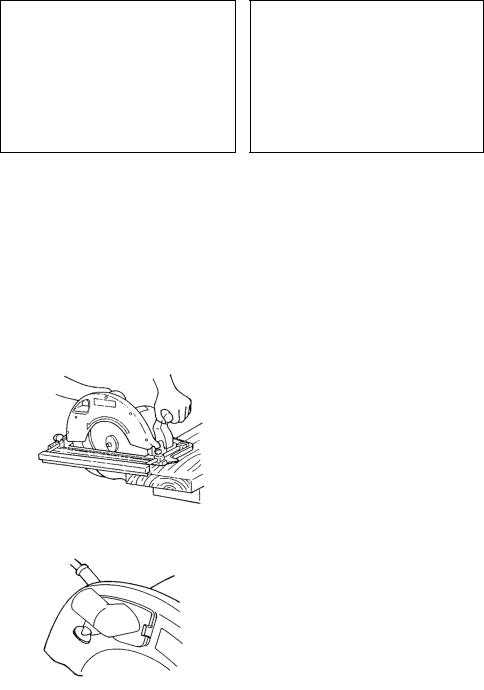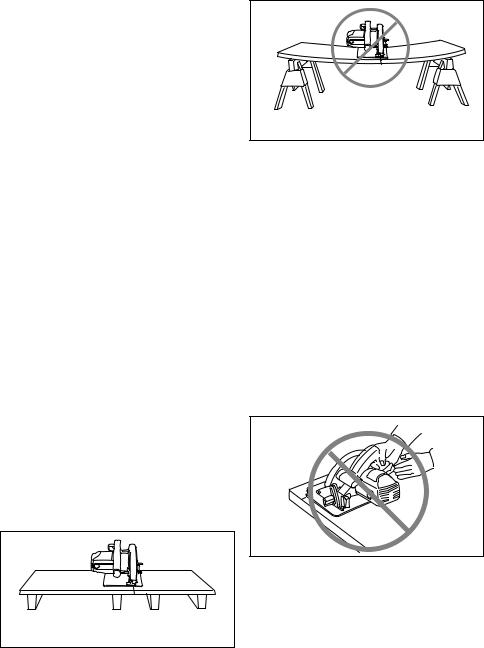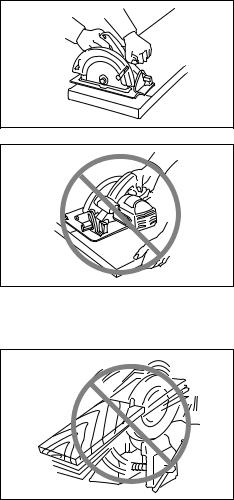Makita 5903R, 5143R, 5703R User Manual

|
|
|
|
|
|
|
|
|
GB |
Circular Saw |
Instruction Manual |
|
|
|
|
|
|
Scie circulaire |
Manuel d’instructions |
|
F |
||
|
|
|
|
|
|
Handkreissäge |
Betriebsanleitung |
|
D |
||
|
|
|
|
|
|
Sega circolare |
Istruzioni per l’uso |
|
I |
||
|
|
|
|
|
|
Cirkelzaagmachine |
Gebruiksaanwijzing |
|
NL |
||
|
|
|
|
|
|
Sierra circular |
Manual de instrucciones |
|
E |
||
|
|
|
|
|
|
Serra circular |
Manual de instruções |
|
P |
||
|
|
|
|
|
|
Rundsav |
Brugsanvisning |
|
DK |
||
|
|
|
|
|
|
Cirkelsåg |
Bruksanvisning |
|
S |
||
|
|
|
|
|
|
Sirkelsag |
Bruksanvisning |
|
N |
||
|
|
|
|
|
|
Pyörösahat |
Käyttöohje |
|
FIN |
||
|
|
|
|
|
|
∆ισκ πρί ν |
δηγίες ρήσεως |
|
GR |
||
|
|
|
|
|
|
|
|
|
TR |
Dairesel bıçkı |
El kitabı |
|
|
|
|
165 mm 5603R
190 mm 5703R
235 mm 5903R
270 mm 5103R
355 mm 5143R

1 |
2 |
|
|
|
|
|
|
|
3 |
4 |
|
|
|
|
|
|
|
5 |
6 |
|
|
|
|
|
|
|
7 |
8 |
2

9 |
10 |
|
|
|
|
|
|
|
11 |
12 |
|
|
|
|
|
|
|
13 |
14 |
|
|
|
|
|
|
|
15 |
16 |
3

17 |
18 |
4

ENGLISH
Explanation of general view
1 |
Hex wrench |
13 |
Cutting depth |
26 |
30° angle cuts |
2 |
Shaft lock |
14 |
Loosen |
27 |
Straight cuts |
3 |
Tighten |
15 |
Lever |
28 |
Blade |
4 |
Loosen |
16 |
Thumb nut |
29 |
Base |
5 |
Saw blade |
17 |
For 45° bevel cuts |
30 |
Top guide |
6 |
Outer flange |
18 |
For straight cuts |
31 |
Lock-off button |
7 |
Inner flange |
19 |
Base plate |
32 |
Switch trigger |
8 |
Outer flange |
20 |
45° angle cuts |
33 |
Vacuum cleaner |
9 |
Hex socket head bolt |
21 |
Straight cuts |
34 |
Limit mark |
10 |
Saw blade |
22 |
Top guide |
35 |
Brush holder cap |
11 |
Setting protuberances |
23 |
Base |
36 |
Screwdriver |
12 |
Hex socket head bolt |
24 |
60° angle cuts |
|
|
|
(For adjusting riving knife) |
25 |
45° angle cuts |
|
|
SPECIFICATIONS
Model |
5603R |
5703R |
5903R |
5103R |
5143R |
Blade diameter ............................................... |
165 mm |
190 mm |
235 mm |
270 mm |
355 mm |
Max. cutting depth |
|
|
|
|
|
At 90° .......................................................... |
54 mm |
66 mm |
85 mm |
100 mm |
130 mm |
At 45° .......................................................... |
38 mm |
46 mm |
64 mm |
73 mm |
90 mm |
No load speed (min–1) ................................... |
5,000 |
4,800 |
4,500 |
3,800 |
2,700 |
Overall length ................................................ |
330 mm |
356 mm |
400 mm |
442 mm |
607 mm |
Net weight ...................................................... |
4.2 kg |
5.2 kg |
7.6 kg |
9.4 kg |
14.5 kg |
|
|
|
|
|
|
•Due to our continuing program of research and development, the specifications herein are subject to change without notice.
•Note: Specifications may differ from country to country.
Power supply
The tool should be connected only to a power supply of the same voltage as indicated on the nameplate, and can only be operated on single-phase AC supply. They are double-insulated in accordance with European Standard and can, therefore, also be used from sockets without earth wire.
Safety hints
For your own safety, please refer to the enclosed Safety instructions.
SPECIFIC SAFETY RULES
GEB029-1
4.Never hold piece being cut in your hands or across your leg. Secure the workpiece to stable platform. It is important to support the work properly to minimize body exposure, blade binding, or loss of control. (Fig. A)
A typical illustration of proper hand support, workpiece support, and supply cord routing (if applicable).
DO NOT let comfort or familiarity with product (gained from repeated use) replace strict adherence to circular saw safety rules. If you use this tool unsafely or incorrectly, you can suffer serious personal injury.
Danger:
1.Keep hands away from cutting area and the blade. Keep your second hand on auxiliary handle, or motor housing. If both hands are holding the saw, they cannot be cut by the blade.
2.Do not reach underneath the workpiece. The guard cannot protect you from the blade below the workpiece. Do not attempt to remove cut material when blade is moving.
CAUTION: Blades coast after turn off. Wait until blade stops before grasping cut material.
3.Adjust the cutting depth to the thickness of the workpiece. Less than a full tooth of the blade teeth should be visible below the workpiece.
Fig. A
5.Hold power tool by insulated gripping surfaces when performing an operation where the cutting tool may contact hidden wiring or its own cord.
Contact with a “live” wire will also make exposed metal parts of the power tool “live” and shock the operator.
6.When ripping always use a rip fence or straight edge guide. This improves the accuracy cut and reduces the chance of blade binding.
7.Always use blades with correct size and shape (diamond versus round) of arbour holes. Blades that do not match the mounting hardware of the saw will run eccentrically, causing loss of control.
8.Never use damaged or incorrect blade washers or bolt. The blade washers and bolt were specially designed for your saw, for optimum performance and safety of operation.
5

9.Causes and Operator Prevention of Kickback:
–kickback is a sudden reaction to a pinched, bound or misaligned saw blade, causing an uncontrolled saw to lift up and out of the workpiece toward the operator;
–when the blade is pinched or bound tightly by the kerf closing down, the blade stalls and the motor reaction drives the unit rapidly back toward the operator;
–if the blade becomes twisted or misaligned in the cut, the teeth at the back edge of the blade can dig into the top surface of the wood causing the blade to climb out of the kerf and jump back toward the operator.
Kickback is the result of saw misuse and/or incorrect operating procedures or conditions and can be avoided by taking proper precautions as given below.
•Maintain a firm grip with both hands on the saw and position your arms to resist kickback forces. Position your body to either side of the blade, but not in line with the blade. Kickback could cause the saw to jump backwards, but kickback forces can be controlled by the operator, if proper precautions are taken.
•When blade is binding, or when interrupting a cut for any reason, release the trigger and hold the saw motionless in the material until the blade comes to a complete stop. Never attempt to remove the saw from the work or pull the saw backward while the blade is in motion or kickback may occur. Investigate and take corrective actions to eliminate the cause of blade binding.
•When restarting a saw in the workpiece, centre the saw blade in the kerf and check that saw teeth are not engaged into the material. If saw blade is binding, it may walk up or kickback from the workpiece as the saw is restarted.
•Support large panels to minimise the risk of blade pinching and kickback. Large panels tend to sag under their own weight. Supports must be placed under the panel on both sides, near the line of cut and near the edge of the panel.
•To minimize the risk of blade pinching and kickback. When cutting operation requires the resting of the saw on the workpiece, the saw should be rested on the larger portion and the smaller piece cut off. (Fig. B & C)
To avoid kickback, do support board or panel near the cut.
Fig. B
Don’t support board or panel away from the cut.
Fig. C
•Do not use dull or damaged blades. Unsharpened or improperly set blades produce narrow kerf causing excessive friction, blade binding and kickback. Keep blade sharp and clean. Gum and wood pitch hardened on blades slows saw and increases potential for kickback. Keep blade clean by first removing it from tool, then cleaning it with gum and pitch remover, hot water or kerosene. Never use gasoline.
•Blade depth and bevel adjusting locking levers must be tight and secure before making cut. If blade adjustment shifts while cutting, it may cause binding and kickback.
•Use extra caution when making a “plunge cut” into existing walls or other blind areas. The protruding blade may cut objects that can cause kickback. For plunge cuts, retract lower guard using retracting handle.
•ALWAYS hold the tool firmly with both hands. NEVER place your hand or fingers behind the saw. If kickback occurs, the saw could easily jump backwards over your hand, leading to serious personal injury. (Fig. D)
Fig. D
•Never force the saw. Forcing the saw can cause uneven cuts, loss of accuracy, and possible kickback. Push the saw forward at a speed so that the blade cuts without slowing.
6

10.Check lower guard for proper closing before each use. Do not operate the saw if lower guard does not move freely and close instantly. Never clamp or tie the lower guard into the open position. If saw is accidentally dropped, lower guard may be bent. Raise the lower guard with the retracting handle and make sure it moves freely and does not touch the blade or any other part, in all angles and depths of cut. To check lower guard, open lower guard by hand, then release and watch guard closure. Also check to see that retracting handle does not touch tool housing. Leaving blade exposed is VERY DANGEROUS and can lead to serious personal injury.
11.Check the operation of the lower guard spring. If the guard and the spring are not operating properly, they must be serviced before use. Lower guard may operate sluggishly due to damaged parts, gummy deposits, or a build-up of debris.
12.Lower guard should be retracted manually only for special cuts such as “plunge cuts” and “compound cuts.” Raise lower guard by retracting handle and as soon as blade enters the material, the lower guard must be released. For all other sawing, the lower guard should operate automatically.
13.Always observe that the lower guard is covering the blade before placing saw down on bench or floor. An unprotected, coasting blade will cause the saw to walk backwards, cutting whatever is in its path. Be aware of the time it takes for the blade to stop after switch is released. Before setting the tool down after completing a cut, be sure that the lower guard has closed and the blade has come to a complete stop.
14.Use the appropriate riving knife for the blade being used. For the riving knife to work, it must be thicker than the body of the blade but thinner than the tooth set of the blade.
15.Adjust the riving knife as described in this instruction manual. Incorrect spacing, positioning and alignment can make the riving knife ineffective in preventing kickback.
16.Always use the riving knife except when plunge cutting. Riving knife must be replaced after plunge cutting. Riving knife causes interference during plunge cutting and can create kickback.
17.For the riving knife to work, it must be engaged in the workpiece. The riving knife is ineffective in preventing kickback during short cuts.
18.Do not operate the saw if riving knife is bent.
Even a light interference can slow the closing rate of a guard.
19.Use extra caution when cutting damp wood, pressure treated lumber, or wood containing knots. Adjust speed of cut to maintain smooth advancement of tool without decrease in blade speed.
20.Avoid Cutting Nails. Inspect for and remove all nails from lumber before cutting.
21.Place the wider portion of the saw base on that part of the workpiece which is solidly supported, not on the section that will fall off when the cut is made. As examples, Fig. E illustrates the RIGHT way to cut off the end of a board, and Fig. F the WRONG way. If the workpiece is short or small, clamp it down. DO NOT TRY TO HOLD SHORT PIECES BY HAND! (Fig. E & F)
Fig. E
Fig. F
22.Never attempt to saw with the circular saw held upside down in a vise. This is extremely dangerous and can lead to serious accidents. (Fig. G)
Fig. G
23.Some material contains chemicals which may be toxic. Take caution to prevent dust inhalation and skin contact. Follow material supplier safety data.
24.Do not stop the blades by lateral pressure on the saw blade.
25.Always use blades recommended in this manual. Do not use any abrasive wheels.
7
26.Wear a dust mask and hearing protection when use the tool.
SAVE THESE INSTRUCTIONS.
WARNING:
MISUSE or failure to follow the safety rules stated in this instruction manual may cause serious personal injury.
OPERATING INSTRUCTIONS
Removing or installing saw blade
The following blade can be used with this tool.
Model |
Max. dia. |
Min. dia. |
Blade thickness |
Kerf |
|
|
|
|
|
5603R |
165 mm |
150 mm |
Less than 1.7 mm |
More than 1.9 mm |
|
|
|
|
|
5703R |
190 mm |
170 mm |
Less than 1.7 mm |
More than 1.9 mm |
|
|
|
|
|
5903R |
235 mm |
210 mm |
Less than 1.9 mm |
More than 2.1 mm |
|
|
|
|
|
5103R |
270 mm |
260 mm |
Less than 1.8 mm |
More than 2.2 mm |
|
|
|
|
|
5143R |
355 mm |
350 mm |
Less than 2.3 mm |
More than 2.7 mm |
|
|
|
|
|
The thickness of the riving knife is 1.8 mm for Models 5603R and 5703R or 2.0 mm for Model 5903R and 5103R or 2.5 mm for Model 5143R.
CAUTION:
•Do not use saw blades which do not comply with the characteristics specified in these instructions.
•Do not use saw blades the disc of which is thicker or the set of which is smaller than the thickness of the riving knife.
To remove the saw blade, depress the shaft lock fully to prevent shaft rotation, then use the hex wrench to loosen the hex socket head bolt. (Fig. 1)
Now remove the outer flange, raise the safety cover as much as possible, and remove the saw blade. (Fig. 2)
Install the saw blade using the reverse of the removal procedure. Install the inner flange, saw blade, outer flange and hex socket head bolt, in that order. Be sure to secure the hex socket head bolt tightly with the shaft lock fully depressed. (Fig. 1 & 3)
CAUTION:
•Make sure that the blade teeth point forward in the same direction as the tool rotation (the arrow on the blade should point in the same direction as the arrow on the tool).
•Never depress the shaft lock while the saw is running.
•Use only the Makita socket wrench to remove or install the blade.
Riving knife adjustment (Fig. 4)
Use the socket wrench to loosen the hex head socket bolt for the riving knife adjustment, then raise the safety cover. Move the riving knife up or down over the two protuberances for settings indicated in the illustration, so as to obtain the proper clearance between the riving knife and saw blade.
CAUTION:
Ensure that the riving knife is adjusted such that: The distance between the riving knife and the toothed rim of the saw blade is not more than 5 mm. The toothed rim does not extend more than 5 mm beyond the lower edge of the riving knife.
Adjusting depth of cut (Fig. 5)
Loosen the lever on the depth guide and move the base up or down. At a desired depth of cut, secure the base by tightening the lever.
CAUTION:
•Use a shallow depth of cut when cutting thin workpiece for cleaner, safer cuts.
•After adjusting the depth of cut, always tighten the lever securely.
Adjusting for bevel cuts (Fig. 6)
Loosen the thumb nuts in front and back, and tilt the tool to the desired angle for bevel cuts (0 – 45° ). Secure the thumb nuts tightly in front and back after making the adjustment.
Sighting (5603R, 5703R) (Fig. 7)
For straight cuts, align the right notch on the front of the base with your cutting line on the workpiece. For 45° bevel cuts, align the left notch with it.
Top guide (5903R, 5103R) (Fig. 8)
Align your sight line with either the 0° notch for straight cutting or the 45° notch for 45° angle cuts.
Top guide (5143R) (Fig. 9)
Align your sight line with either the 0° notch for straight cutting or the 30° notch for 30° angle cuts or the 45° notch for 45° angle cuts or the 60° notch for 60° angle cuts.
Switch action (Fig. 10)
To prevent the switch trigger from being accidentally pulled, a lock-off button is provided. To start the tool, depress the lock-off button and pull the switch trigger. Release the switch trigger to stop.
CAUTION:
•Before plugging in the tool, always check to see that the switch trigger actuates properly and returns to the “OFF” position when released.
8
Operation (Fig. 11)
Hold the tool firmly. Set the base plate on the workpiece to be cut without the blade making any contact. Then turn the tool on and wait until the blade attains full speed. Now simply move the tool forward over the workpiece surface, keeping it flat and advancing smoothly until the sawing is completed. To get clean cuts, keep your sawing line straight and your speed of advance uniform.
CAUTION:
•The riving knife should always be used except when plunging in the middle of the workpiece.
•Do not stop the saw blade by lateral pressure on the disc.
Guide rule (Fig. 12 & 13)
The handy guide rule allows you to do extra-accurate straight cuts. Simply slide the guide rule up snugly against the side of the workpiece and secure it in position with the screw on the front of the base. It also makes repeated cuts of uniform width possible.
Joint assembly (Fig. 14, 15 & 16)
(for connecting a vacuum cleaner)
When you wish to perform clean cutting operation, connect a vacuum cleaner to your tool. Install the joint on the tool using the screw. Then connect a hose of vacuum cleaner to the joint.
MAINTENANCE
CAUTION:
Always be sure that the tool is switched off and unplugged before carrying out any work on the tool.
To maintain product safety and reliability, repairs, maintenance or adjustment should be carried out by a Makita Authorized Service Center.
9
